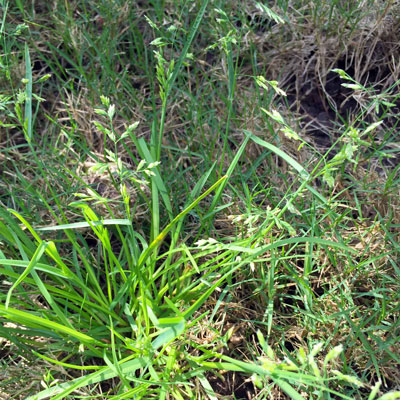Cranking Up the Lawn for Spring
I spent six weeks writing the “Lawns” chapter in my book. I don’t think I’d better spend that much time or space here. But what I will do is give you my spring tips on getting your lawn up and running for the warm months ahead.
I’ll tell you things I do, and things I do not do (that other people ask about). And I’ll do them in quick-read bullets.
Spring Lawn Care Guidelines…
• Apply broadleafed weedkiller spray (containing 2,4-D) to control non-grassy weeds such as dandelions, chickweed, clover, thistles and plantain, among many others.

• Mow at recommended height for the type of grass that you’re growing.
• Mow frequently to remove seedheads from winter grassy weeds such as ryegrass and rescuegrass. There is no chemical product that will eliminate them now. That can only be done with pre-emergent granules Aug. 25-Labor Day.

• Apply high-quality, all-nitrogen lawn fertilizer containing up to half slow-release nitrogen. Note: these fertilizers often contain a small percentage of potassium (third number of the analysis). What you do not want is any phosphorus (middle number of the analysis). It accumulates in soils to the point of becoming a problem.
• Water regularly to soak the fertilizer into the root zone of the lawn. Intervals between waterings will vary depending on temperature and rainfall.
• Continue mowing every five or six days. That will keep grass low and dense. That will discourage rank weed growth and it will promote good turf runner formation.
• I do not aerate my lawn. Not that it’s a bad thing. I’ve just never felt compelled to do so. If I had compacted soil from excessive pedestrian traffic or cars being parked on it, or if I had a layer of thatch (undecomposed grass clippings on top of the soil and beneath the runners), then I might. Otherwise, I rarely recommend it.
• Do not attempt to overseed bermudagrass lawns with more bermuda seed. It is extremely fine and incapable of competing with established plants. It also washes freely in heavy spring rains.
• Do not use the “patching” kits of grass seed to fill in vacant areas in your lawn. They are not going to contain the same type of grass that you have in the rest of the lawn, so they’ll stand out visibly if they do germinate and grow, plus one type of grass will predominate, so mixes don’t make much sense. Most of those, in my experience, contain grass seed better suited to northern areas anyway. You’re better off planting plugs or seed of the same type of grass you have in the rest of your lawn.
• Do not topdress your entire lawn. I’m not sure where this practice began. I know my dad and I did it when I was a very young kid. He was an ag prof at Texas A&M, and I believe we had loads of manure from one of the barns. So that was probably organic fertilizer. That would be acceptable, but these people who spread topsoil over every square foot – a hard “No” to that. I think that practice has about died out now.
• And the big one: if you’ve had trouble getting grass to grow in an area, do not keep planting sod until you’ve made sure you have enough sunlight. Even St. Augustine, our most shade-tolerant turfgrass, needs 6 hours of direct sunlight daily to do well as a lawngrass. Full sun would be better. There’s no point in spending money time after time if the sod just keeps dying. Maybe your trees have grown larger and cast more shade now than they used to. Switch to a shade-tolerant groundcover. More on that another time here.
